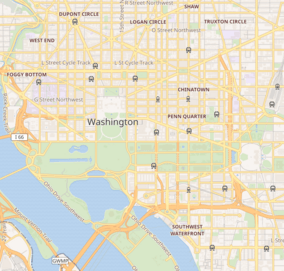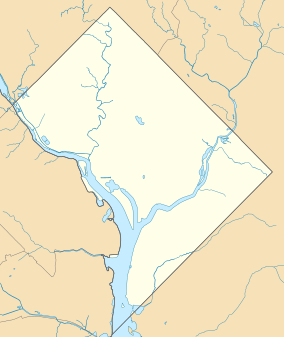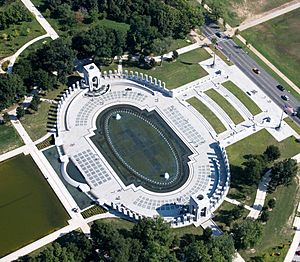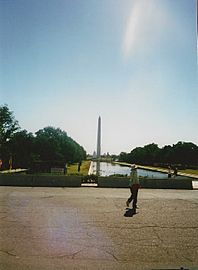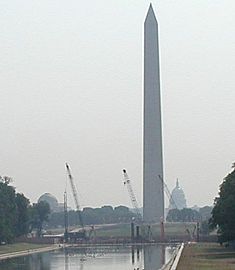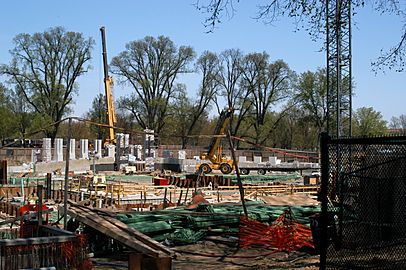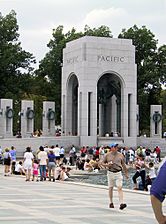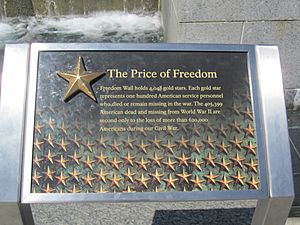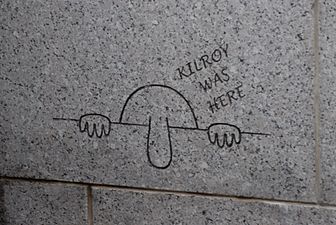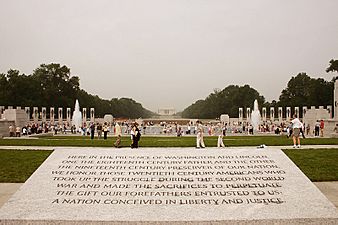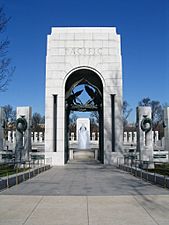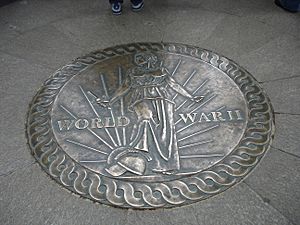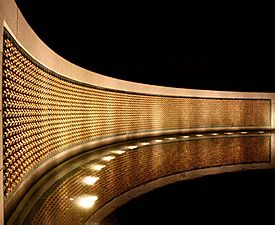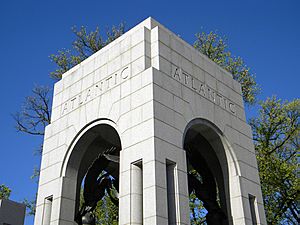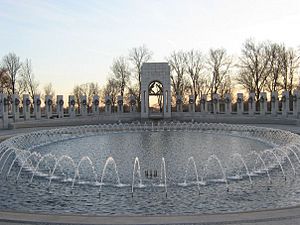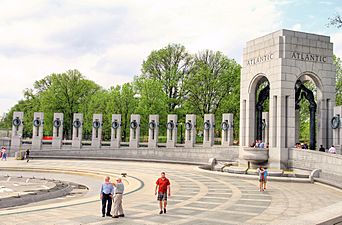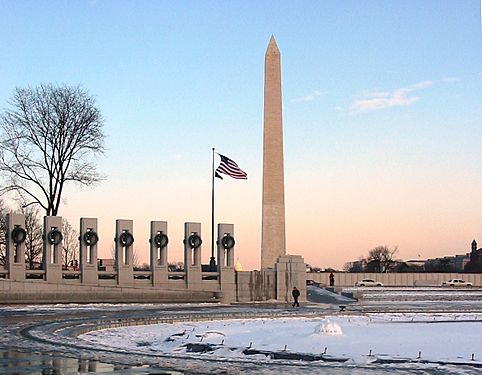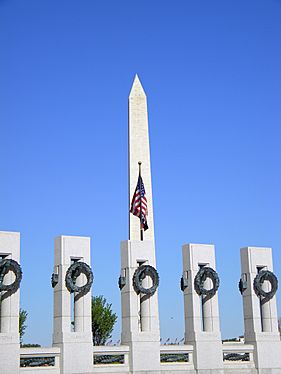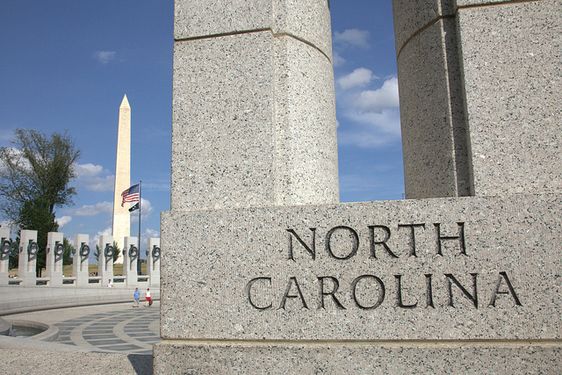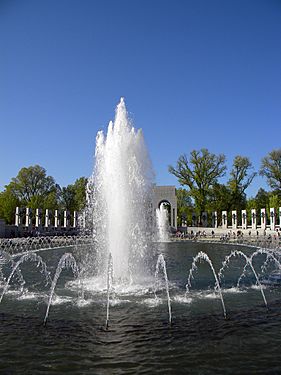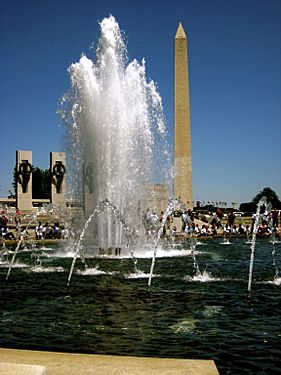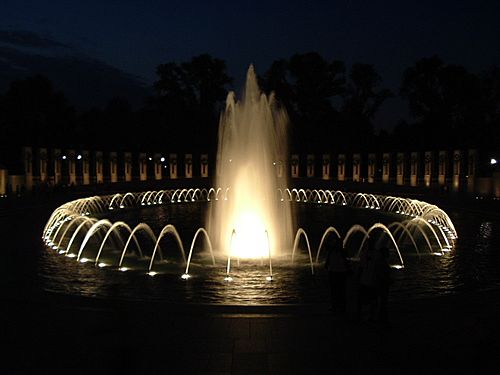World War II Memorial facts for kids
Quick facts for kids World War II Memorial |
|
|---|---|
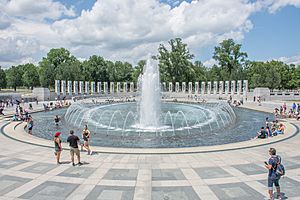
World War II Memorial (2017)
|
|
| Location | Washington, D.C. |
| Established | April 29, 2004 |
| Visitors | 4.6 million (in 2018) |
| Governing body | National Park Service |
| Website | World War II Memorial |
The World War II Memorial is a special place in Washington, D.C.. It honors all the Americans who served in the military and as civilians during World War II. The memorial has 56 tall pillars, which stand for the U.S. states and territories. It also has two large arches, one for the Atlantic Ocean battles and one for the Pacific Ocean battles. These surround a big square and a fountain. You can find it on the National Mall, between the Lincoln Memorial and the Washington Monument.
This memorial opened on April 29, 2004. President George W. Bush officially dedicated it on May 29, 2004. The National Park Service takes care of the memorial. In 2018, over 4.6 million people visited this important site.
Contents
What Does the World War II Memorial Look Like?
The memorial has 56 granite pillars, each about 17 feet (5.2 meters) tall. They form a half-circle around a central area. On opposite sides of this area are two large arches, about 43 feet (13 meters) tall. Most of the 7.4-acre (3-hectare) site is covered with plants and water.
Each pillar has the name of a U.S. state from 1945 carved into it. It also includes the District of Columbia and several territories like Alaska, Hawaii, Puerto Rico, Guam, American Samoa, and the U.S. Virgin Islands. The northern arch is named "Atlantic" for the battles there, and the southern arch is named "Pacific" for those battles. The main square is about 337 feet (103 meters) long and 240 feet (73 meters) wide. It is sunk 6 feet (1.8 meters) below the ground and has a large pool.
You can also find two hidden "Kilroy was here" drawings at the memorial. This famous drawing was a secret message used by American soldiers during World War II. It showed that they had been there and were protecting the area.
As you walk into the memorial from the east, you'll see two walls with pictures carved into them. These pictures show scenes from the war. On the left wall, towards the Pacific arch, the scenes show soldiers getting ready for war and then fighting. They end with soldiers coming home. On the right wall, towards the Atlantic arch, you see similar scenes, but they focus on the European battles. Some pictures show preparations in England. The last scene shows American and Russian armies meeting in Germany.
The Freedom Wall: A Symbol of Sacrifice
The Freedom Wall is on the west side of the memorial. From here, you can see the Reflecting Pool and the Lincoln Memorial. This wall has 4,048 gold stars. Each star stands for 100 Americans who died in the war. In front of the wall, a message reminds visitors: "Here we mark the price of freedom."
How Was the World War II Memorial Built?
The idea for a World War II memorial started in 1987. A veteran named Roger Durbin asked Representative Marcy Kaptur if a memorial could be built. She introduced a bill in Congress, but it didn't pass at first. She tried again two more times, but the bills still didn't become law.
Finally, in 1993, Representative Kaptur tried a fourth time. Senator Strom Thurmond also introduced a similar bill. This time, both the Senate and the House of Representatives approved the idea. President Bill Clinton signed the bill into law on May 25, 1993. This meant the memorial could finally be built!
Raising Money for the Memorial
After the law passed, a special board was created to help choose the site, design the memorial, and raise money. Many individual Americans sent in donations. Large groups of veterans, like the American Legion, also gave money. Two important people, Senator Bob Dole (a World War II veteran) and Frederick W. Smith (the head of FedEx), helped lead the effort to get donations from companies. The U.S. government also gave about $16 million. In total, $197 million was raised to build the memorial.
Choosing the Best Location
The first step was to pick the right spot for the memorial. Many places were considered. Three locations were popular:
- Near the U.S. Capitol Building.
- In Constitution Gardens.
- At Freedom Plaza.
Other places were looked at but quickly rejected. The chosen location was the Rainbow Pool site. This spot is between the Washington Monument and the Lincoln Memorial. It's a very important place on the National Mall. It was the first new monument in this main area in over 70 years.
Designing the Memorial's Look
A competition was held to find the best design. Over 400 architects sent in their ideas. In 1997, the design by Friedrich St. Florian was chosen. His design looks like a classic monument. Under each of the two arches (Pacific and Atlantic), four eagles hold a wreath. Each of the 56 pillars has wreaths of oak, showing military strength, and wheat, showing farm production.
Over the next four years, the design was changed a bit. This was part of the review process for new memorials in Washington, D.C.
Building the World War II Memorial
Construction began in September 2001. The General Services Administration managed the building process.
The large arches were made by a company called Rock of Ages. A sculptor named Raymond Kaskey created the bronze eagles and wreaths under the arches. He also made 24 bronze pictures that show scenes from the war, both fighting and life at home. Another company, Valley Bronze, made the bronze wreaths on the pillars and the 4,048 gold-plated silver stars. Each star represents 100 Americans who died in the war. The lettering for the memorial was designed by The John Stevens Shop, and most of the words were carved by hand right at the site.
The memorial opened to the public on April 29, 2004. A big dedication ceremony was held on May 29, with thousands of people attending. On November 1, the memorial officially became a national park, managed by the National Park Service. In 2012, the memorial's fountain was updated.
- The memorial under construction
Why Some People Disagreed with the Memorial's Location
Some people and groups, like the National Coalition to Save Our Mall, did not like where the memorial was built. A main concern was that it would block the clear view between the Washington Monument and the Lincoln Memorial. They also worried it would take up open space often used for large public gatherings and protests.
Critics were also upset that the approval process for the memorial was sped up. Usually, it takes a very long time to get approval for new memorials. But Congress wanted to make sure the memorial was built before many World War II veterans passed away. So, they passed laws to speed up the process and stop any legal challenges.
Discussions About the Memorial's Design
There were also some disagreements about the memorial's design. Some critics said the design was too grand or too old-fashioned. One newspaper called it "overbearing" and "bombastic."
However, others believed the design fit well with the style of government buildings from the 1930s and 1940s.
The first design only had 50 columns. It honored the 48 states at the time and two territories, Alaska and Hawaii. But then, the Legislative Assembly of Puerto Rico asked for a column to honor Puerto Rico's role in the war. This led to the number of columns being increased to 56. This way, all 48 states, the District of Columbia, and seven territories (Alaska, Hawaii, Puerto Rico, Guam, American Samoa, the Philippines, and the U.S. Virgin Islands) could be honored.
Adding a Prayer to the Memorial
In 2013, Senator Rob Portman suggested adding a plaque with a prayer that President Franklin D. Roosevelt said on D-Day (June 6, 1944). This bill passed in the Senate in 2014. However, some groups disagreed with adding the prayer. They felt the memorial already honored everyone who served and that adding a specific prayer might not represent all veterans.
Gallery
-
A seal on the floor of the memorial using the World War II Victory Medal design
-
Panoramic view at night, Washington Monument in the background
With the Washington Monument in background
Of the Central Fountain
See also
 In Spanish: Memorial nacional a la Segunda Guerra Mundial para niños
In Spanish: Memorial nacional a la Segunda Guerra Mundial para niños


